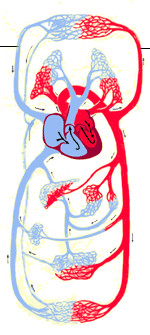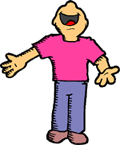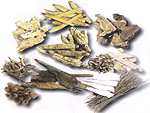Hypertension
Hypertension
|
 |
|
||||||||
| Â |
Blood circulation
|
 |
According to TCM (Traditional Chinese Medicine), there is no term or definition that specifically refers to the modern definition of hypertension. The disease is characterized in TCM by common symptoms like headache, dizziness and light headedness, and comes under related TCM syndrome categories such as “dizziness” and “headache.” Some specific types of hypertension are also related with other TCM syndromes, such as “coma” and “convulsion,” that occur in hypertensive brain disease as well as “pre-eclampsia”, which is the syndrome of severe hypertension during pregnancy.
In ancient China, people did not have effective drugs to control hypertension. As a result it led to the development of many secondary diseases that damaged related organs such as the brain and heart. Stroke, one of the four major syndromes in TCM, often develops from hypertension. Other major syndrome complications include chest discomfort (caused by improper movement of  qi and blood in chest), cardiac asthma (asthma caused by heart disease), and edema (swelling).Â
The diagnosis and treatment of hypertension symptoms are mentioned in a variety of TCM medical classics. The early descriptions of hypertension can be found in the medical classicHuang Di Nei Jing (The Yellow Emperor’s Internal Classic ) written during the Han Dynasty (approx. 200 B.C.). The Treatise of the Truth and Grand Quintessence section under this classic’s Suwen (The Book of Plain Questions) section, has the following to say about dizziness: “dizziness caused by wind evil are related to the liver disorder.” The classic’s Formation of Five Organs section reads,”external evils that invade the head will generally show symptoms like headache and lower limb weakness. “Â
Later many TCM practitioners mentioned hypertension symptoms in their medical classics. For example, under the dizziness section in the book entitled Secret Storage of Orchid Chamber, it reads, “blurred vision and dizziness are caused by wind evil inside the body, and should be treated with the herb named Tall Gastrodia Tube. ” According to the book Guiding Cases for Clinical Treatment, “people with dizziness will soon develop stroke,” and “the cause of headache and dizziness are related to the liver.”Â
In TCM’s view, hypertension usually originates from over stimulation of emotions, internal injuries and improper diet. These external factors cause an imbalance of yin and yang, and disturb of qi and blood movement inside the body. The liver and kidney are usually the most affected. Formation of internal body evils such as wind, fire, phlegm and blood stasis give rise to different TCM syndrome patterns.Â
Causes
As mentioned in the definition section, hypertension is characterized in TCM by its symptoms such as “dizziness” and “headache,” which are the main manifestations of the disease. Factors that trigger hypertension can be classified into the following:
| 1. | Hyperactivity of liver-yang | ||||||||||||||||||
|  | As mentioned in the Chinese medical classics, dizziness caused by wind evil is related to the liver disorder. The liver dominates the conducting and dispersing of qi movement; liver-yang has the property of upward motion and causes qi or other fluids to ascend, while liver-yin has the property of static motion and causes qi, blood and other fluids to descend. Yin and yang mutually restrict and promote each other in order to maintain balance in the body. Hyperactivity of liver-yang and deficiency of liver-yin triggers the qi and blood to ascend to the brain. The acceleration of qi movement also produces wind evils, and leads to symptoms of dizziness, tremors or sudden black outs. Hyperactivity of liver-yang happens when:
|
||||||||||||||||||
| 2. | Liver-wind and turbid phlegm evils attack upwards | ||||||||||||||||||
|  | When the body is ill, yin and yang become imbalanced, and internal disease causing factors like wind and phlegm evils interact with each other. At the same time when the body is in a state of hyperactivity of liver-yang, which means the body has accumulated wind evils too; the wind evils mix with phlegm evils and flow upwards in the body easily. They disturb the meridians and cause the non-smooth circulation of qi and blood. This results in unconsciousness or numbness of limbs that are serious symptoms of hypertension. Accumulation of phlegm happens when:Â
|
||||||||||||||||||
| 3. | Imbalance of Yin and yang | ||||||||||||||||||
|  | The qi (vital energy) and essence are the main nutrient substances for maintaining the life activities of body. This is the fundamental root of the yin and yang of the whole body. When people get older, kidney-qi will become insufficient, and imbalance of yin and yang will result in the weakening and loss of these nutrients from the kidney. Yin deficiency occurs in the lower part, excessive of yang occurs in the upper part of the body. Yin and yang loss restrains forces inside the body. For example, virtual fire evils (caused by a yang excess) flares up in the upper part of body and causes hypertensive symptoms. | ||||||||||||||||||
| 4. | Other related causes | ||||||||||||||||||
| Â | Although other causes of hypertension are still under investigation, researchers have found the following factors do contribute to the causes:
|
Symptoms
The clinical features of hypertension are non-specific, and the only obvious symptoms are dizziness and headache. This can be accompanied with a group of symptoms that are related to the types of disharmony patterns. For example, when it is a yang pattern, then individuals will have heat-manifested signs like high fever, aversion to heat, dark urine, or constipation. The clinical features are usually mild and not very obvious. As a result, most individuals would neglect it. Hypertension is most often diagnosed during a routine medical examination or a special screening program. When the TCM practitioner diagnoses the disharmony patterns associated with the disease, it usually means it has progressed to a stage where complications or organ damage has already occurred. Characteristics of the disease are accompanied by a variety of clinical features. Symptoms vary greatly in patterns and degrees among individuals, so the degree of severity may not coincide with the clinical stage. Hypertension can be classified into following disharmony patterns:
1. Hyperactivity of  liver-yang
Symptoms include dizziness, ringing in the ears, pounding and throbbing pain in the head, irritability, insomnia and fitful sleep, and in some cases the individual’s face may appear flushed. Additional symptoms may include a bitter taste in the mouth, constipation, dark-colored urine and blood-shot eyes. The tongue appears red and is coated with yellow-colored fur. The pulse sign is stringy and rapid. In severe cases, individuals will experience dizziness, nausea, severe headaches, slurred speech, and numb or tremorous limbs that result in instability while walking.Â
2. Deficiency of yin and Yang HyperactivityÂ
Symptoms include soreness of the lumbar (lower back) region, weakness in the knees, memory loss, and premature ejaculation. The tongue appears thin and tender, or tender and red, and is covered with little or no fur. The pulse sign is stringy and thready or rapid.
In more severe cases, individuals may have headaches, flushed cheeks, and dryness in the throat. They may also experience excessive weight loss, and a burning and hot sensation in the chest, palms and soles. The tongue is tender and red and coated with little fur or fur that appears scaled. The pulse sign is thready and rapid.Â
3. Liver-Wind and Turbid Phlegm
The symptoms include dizziness, severe weakness or a feeling of heaviness in the head. There is dullness in the chest, and the individual vomits, and suffers from ringing in the ears and blurred vision. In more severe cases, individuals may experience numbness in the limbs, sudden distortion of the face (facial paralysis), difficulty in speech, drooling and even hemiparalysis (paralysis of one side of body). The tongue coating is greasy with yellow or white color. The pulse sign is stringy and rolling.Â
4. Deficiency in Yin and Yang
Symptoms include dizziness, pounding and throbbing pain in the head, and irritability. Sometimes individuals appear flushed in the face, and experience fever and sweating. In other cases, the body’s temperature is low, the limbs are cold, and there is an aversion to cold temperatures. When an individual reaches middle age (about 40-years-old), the female may have irregular menstruation, and the male experience impotence. In addition, they may occasionally have a flushed face and fever, and the lower limbs feel cold. The tongue is pink with a thin fur coating, and the pulse is soft and thready.
Diagnosis
Nowadays, hypertension is largely diagnosed by above normal readings of blood pressure measured on three separate occasions. (Please see western medicine diagnosis section for reference).
TCM practitioners will diagnosis hypertension according to its clinical symptoms and further characterizes it by the disharmony patterns displayed by individuals. (See below)
 |
TCM Examination Techniques:
Diagnosis in TCM is based on four examination techniques. The first is “questioning.” The TCM practitioner will want to know what the individual’s current complaints are, and their family’s medical history. The second technique is “observation.” Physical features of the body such as the face, tongue, hair, nails, sputum (mucus that is coughed up) and examining the area of pain all offer clues to the problem. Examining the tongue is particularly useful as a gage to assess illness because it is seen as a window to look at the functioning of internal organs. The third technique is “hearing and smelling.” Smelling the sputum and breath and listening to the sounds coming from the chest offer additional clues. The last technique used in examination is “touching.” Feeling the pulse is a cornerstone of TCM diagnosis and gives the TCM practitioner a lot of information about the body’s imbalance.Â
Note:Â If a TCM practitioner suspects there might be a serious problem that Chinese medicine alone cannot treat, he or she will recommend the individual see a western doctor for further follow up.Â
The Four Types of Disharmony Patterns The information gathered from the TCM examination is used to determine which type of disharmony pattern an individual has. This is important because at the various stages of a disease, varieties of disharmony patterns are present which require different types of therapy. This is the reason two individuals with the same disease may be treated very differently by their TCM practitioners.Â
1. Hyperactivity of liver-yangÂ
According to the “five elements theory,” liver and wind evils belong to the element wood, which have ascending motion properties. Those physiological functions of the liver are considered to be yang. Excessive yang and stirring up wind evils will affect the brain, and cause dizziness and headache symptoms because it interferes with the ascending motion of the liver.
2. Yin Deficiency and YangHyperactivityÂ
The body’s physiological functions (yang) and physical forms (yin) are maintained in dynamic balance to achieve health. When the body is injured internally (yin deficiency), physiological hyper-function occurs and reveals heat symptoms like headache, fever and sweating.
3. Liver-Wind and Turbid Phlegm
Phlegm evil results from the impaired function of the spleen and stomach. These organs are affected by liver-wind evil that goes to the head, and obscures the meridian and orifices that eventually leads to severe hypertension with symptoms of facial distortion, and paralysis.Â
4. Deficiency in Yin and Yang
Both internal injury (yin) and dysfunction of organs (yang) will cause the body to lose harmony, and suffer worse manifestations such as low body temperature and a soft pulse sign, which means the vital signs are weak.Â
Hypertension should be differentiated from conditions where hypertension is caused by a specific disease process.Â
Secondary hypertension is more common, and therefore more frequently seen in:
| Individuals with clinical or biochemical features of a specific disorder. For example, blood hormone levels (catecholamines) that are above normal range suggest an endocrine disease of pheochromocytoma. | |
| Young patients (30-years-old and under) | |
| Accelerated hypertension (severe cases of hypertension) suggests cardiovascular causes like aneurysm. | |
| Troublesome hypertension (hypertension that does not respond to medication) suggests renal causes like congenital polycystic kidneys. |
Â
Treatment
Treatment of hypertension from a TCM perspective is tailored according the disharmony pattern an individual has. Below are some examples of therapies used in treating the different disharmony patterns associated with this disease.
| 1. Hyperactivity of liver-yang |
Therapeutic aim: Suppress the hyperactive liver, calm down the body’s yang, expel fire evils and extinguish the wind evil.
Prescription:Â Tianma Gouteng Drink
| Tian man | Tall gastrodia tuber |
| Gou teng | Gambir plant |
| Sheng shi jue | Abalone shell |
| Niu xi | Achyranthes root |
| Yi mu cao | Motherwort herb |
| Huang qin | Baical skullcap root |
| Shan zhi | Cape jasmine furit |
| Du zhong | Eucommia bark |
| Sang ji sheng | Chinese taxillus herb |
| Ye jiao teng | Fleece flower stem |
| Fu shen | Poria with hostwood |
| 2. Yin Deficiency and Yang Hyperactivity |
Therapeutic aim:Â Nourish yin and calm down the yang.Â
Prescription: Zhengan Xifeng Decoction
| Sheng gui ban | Fresh tortoise shell |
| Sheng bai shao | Fresh white peony root |
| Xuan shen | Figwort |
| Tian dong | Cochinchinese asparagus root |
| Huai niu xi | Achyranthes root |
| Sheng zhe shi | Raw ochre |
| Sheng long gu | Raw fossil bone |
| Sheng mu li | Fresh oyster shell |
| Chuna lian zi | Szechwan chinaberry fruit |
| Sheng mai ya | Fresh germinated barley |
| Qing hao | Sweet wormwood herb |
| Gan cao | Liquorice root |
| 3. Liver-Wind and Turbid Phlegm |
Therapeutic aim:Â Expel the phlegm evil, arrest the wind evil and remove the obstruction in collaterals.Â
Prescription:Â Daotan Decoction plus addition and deduction of Qianzheng Powder
| Zhi ban xia | Processed pinellia tuber |
| Dan nan xing | Bile arisaema |
| Chen pi | Dired citrus peel |
| Fu ling | Indian bread |
| Zhi shi | Immature orange seed |
| Gan cao | Liquorice root |
| Bai fu zi | Giant typhonium rhizome |
| Jiang can | Stiff silkworm |
| Quan xie | Scorpion |
| Tian man | Tall gastrodia tuber |
| 4. Deficiency in Yin and Yang |
Therapeutic aim:Â Warm up the kidney-yang, nourish the kidney-yin, eliminate kidney-fire and regulate the meridian.
Prescription:
Erxian Decoction
| Xian mao | Common curculigo root |
| Xian ling pi | Epimedium herb |
| Zhi mu | Common anemarrhena |
| Huang bai | Amur cork-tree |
| Dang jui | Chinese angelica |
| Ba ju ru | Indian mulberry |
Prevention
|
Contact author: Dr. Ken Wang





